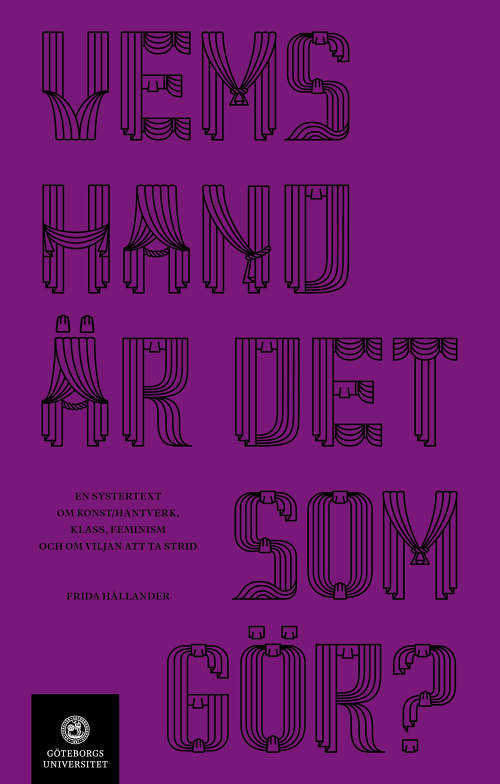Vems hand är det som gör?
Frida Hållander ställer i avhandlingen frågor som: Vems hand är det som gör? Och hur kan vi genom görandefallstudier förstå konsthantverkliga praktiker som går i dialog med samhället genom görande och objekt? Hur kan vi förstå objekt som manifesterar motstånd? Är subversiva handlingar möjliga genom konsthantverk? Hur kommer sociala, feministiska och politiska rörelser att bli berättade genom objekt?
Genom en praktikbaserad forskning som rör sig mellan skilda rum och tider, undersöker Hållander frågor om makt, motstånd, konst/hantverk och objekt. I avhandlingen skapas ett viljefullhetens arkiv i kollektiva processer och med utgångspunkt från de två tematiska materialen keramik och textil.
Boken är slutsåld (maj 2019)
Avhandlingen finns fritt tillgänglig i digital form via Göteborgs universitet, https://gupea.ub.gu.se/handle/2077/58486

English:
Whose hand is making? And how can we understand craft practices in dialogue with society through making and objects? How do we understand objects that manifest resistance? This dissertation in artistic research explores craft practices within the fields of ceramics and textile, through the method and form of autoethnography, and on the basis of an intersectional perspective. It understands making as embodied experience and knowledge, conditioned, but not always bounded, by societal structures, and it documents the resistance against, and the resilience of, repressive structures, in dialogues and struggles where objects gain agency. It is an examination that moves between the bookishness of libraries and historical trajectories on the one hand and making as collective practice on the other, the latter represented in what this study defines as case studies of making. The study creates the term “together-making” to describe and analyse collective craft practice as simultaneously a method of research and of making as a potentially political and socially-conscious act. Through two case studies of making the study assembles an archive of willfulness. In the first case study of making, ceramic practice and historical objects emanating from feminist and anti-slavery movements, are explored through a process of together-making, putting together the exhibition From Pottery to Politics in 2016. In the actual exhibition, further ceramic objects from Swedish twentieth century come into play to re-direct the shape of the exhibition, exemplifying the ways in which this study understands objects as manifest, material politics inciting response. The second case study of making, takes off from the geographical area known as »de sju häraderna«: a centre for Swedish textile manufacture and home-based industry since the seventeenth century. Focusing on a group of local seamstresses who organized Sweden’s first women’s football series in the 1960s – Öxabäck IF – the study investigates textile objects in dialogue with society reflected through the textile history of labour and feminist political movements in the nineteenth and twentieth century. This case study also documents the process of research through together-making, and the exhibition Öxabäck IF – Without You no Tomorrow, 2016.